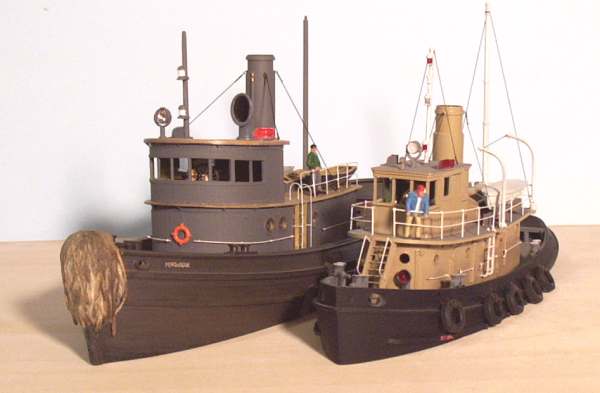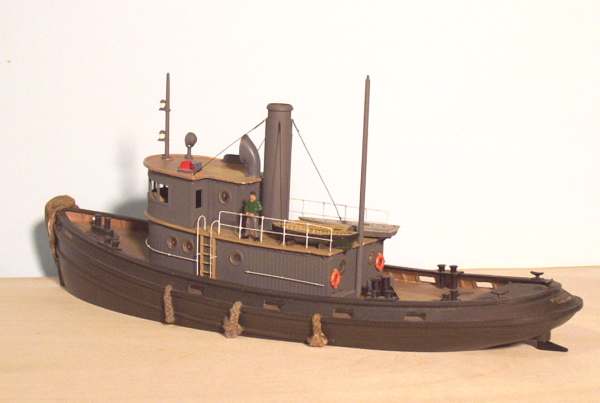Posts: 1,682
Threads: 101
Joined: Dec 2011
In preparation to build a new layout centered on Erie's Harlem Station in NYC, I decided to kitbash a Lindberg Coast Guard tugboat we didn't use on our club layout.
![[Image: IMG_7718b.jpg]](http://3.bp.blogspot.com/-m1kR83c-wcU/VZX5AMwZ9TI/AAAAAAAAA8I/VPNnlYUi51I/s1600/IMG_7718b.jpg)
I could have built it as is, but I know myself and decided to tweak it a little bit... and finally it ended a plain bashing session.
![[Image: IMG_7717b.jpg]](http://2.bp.blogspot.com/-v_0KUiqSYEg/VZX4_55-TsI/AAAAAAAAA8Q/nN6f-UcW_8k/s1600/IMG_7717b.jpg)
The prototype is named Chicago: a 1913 tugboat built and modified to navigate Harlem River. The Lindberg hull is almost a perfect match and thus worth the effort. The plastic model is a wooden ship, but I sanded down the wood plank texture to make it a steel vessel.
![[Image: IMG_6771b.jpg]](http://1.bp.blogspot.com/-NQ7kODBtVUY/VZX6r2jM_5I/AAAAAAAAA8o/RhIOQWfXdzY/s1600/IMG_6771b.jpg)
The hull was cut on my table saw to get a waterline model. Each half was securely glued on a plank of masonite before the surgery. Extreme caution must be exerted. It is a small operation, but plastic is always unpredictable under the blade.
![[Image: IMG_7720b.jpg]](http://3.bp.blogspot.com/-IcAJzqdmCEA/VZX5AZe33zI/AAAAAAAAA8c/Rf7tvFswI-Y/s1600/IMG_7720b.jpg)
Main modifications include lenghtening the superstructure, removing the winch and bashing the wheelhouse. I'll also have to bash the steam stack (round) into a diesel one (ovale).
![[Image: IMG_7722b.jpg]](http://3.bp.blogspot.com/-gqfi07Cvg_Y/VZX5A3gCk3I/AAAAAAAAA8g/1g9HDzNaHsE/s1600/IMG_7722b.jpg)
BTW, Lindberg label the kit as 1/72, but I did extensive measurement and I can say the only 1/72 are the sailor figures!
Matt
Posts: 1,682
Threads: 101
Joined: Dec 2011
![[Image: IMG_7726b.jpg]](http://3.bp.blogspot.com/-B8v2XPVs11M/VZyAt2recMI/AAAAAAAAA9Y/hGVL1V1fZ5Y/s1600/IMG_7726b.jpg)
While waiting glue to dry, I continue to work on the tugboat, mainly the superstructure. I found out that Chicago had a very low wheelhouse during its steam power era but it was given a few additional feet in height when converted to diesel. I don't know why, but it would mean it wasn't working on Harlem River after the conversion... On another hand, the higher wheelhouse wasn't as high as "normal" ones. Maybe it still navigated the river. No definite answer there.
Matt
Posts: 931
Threads: 68
Joined: Dec 2008
I believe the reason that the tugboat had its wheelhouse height increased was to improve visibility to be able to see over cars on the float - I think the New York Cross Harbour ones have the same modification - it would make it easier to push the floats into the float bridges
Posts: 1,682
Threads: 101
Joined: Dec 2011
shortliner Wrote:I believe the reason that the tugboat had its wheelhouse height increased was to improve visibility to be able to see over cars on the float - I think the New York Cross Harbour ones have the same modification - it would make it easier to push the floats into the float bridges
Make sense. On the most "modern" photo, the wheelhouse window are just barerly exceeding a couple of boxcars on a carfloat. Increased height is about 2-3 feet max.
Matt
Posts: 5,263
Threads: 195
Joined: Apr 2009
That can be quite extreme.
A traditional Rhine river freight boat. Notice the usual wheelhouse height.
![[Image: 800px-Rheinschiff_Temptation_I.JPG]](https://upload.wikimedia.org/wikipedia/commons/thumb/6/68/Rheinschiff_Temptation_I.JPG/800px-Rheinschiff_Temptation_I.JPG)
and one handling container loads. The wheelhouse can be moved up and down depending on bridge clearance and freight height.
![[Image: rheinschiff1.jpg]](http://boellert.com/gfx/fotos/duisburg/rheinschiff1.jpg)
I think the same was true many years ago when boxcars needed to be tugged.
Reinhard
Posts: 4,553
Threads: 100
Joined: Dec 2008
It's been an age since I played with that kit. That hull is about 82' in HO scale.
"Ponquogue" was built from the same kit. It will be interesting to see how different yours will be. I'll enjoy seeing her progress.

Here's "Ponquogue" with a smaller, as yet unnamed "Tow boat" built from, what I remember as, a Revell "Harbor tug" kit.

Bon Voyage
Pete
We always learn far more from our own mistakes, than we will ever learn from another's advice.
The greatest place to live life, is on the sharp leading edge of a learning curve.
Lead me not into temptation.....I can find it myself!
Posts: 1,682
Threads: 101
Joined: Dec 2011
Nice work Sumpter. I have a question. How are tires suspended? I've seen some pictures showing small holes were drilled into the hull to fit a rope. Others show a horizontal rope on top of the hull on which smaller rope are used to suspend the tire. On some other, I've seen the rope seems to be attached on the bridge. I'm a little bit at loss about it.
Reinhard... Chicago was built back in 1913 when boxcars were far lower than later ARR standards. It would make sense they made up for the boxcar height increase when they shopped the tugboat with a diesel engine.
Matt
Posts: 1,548
Threads: 99
Joined: Jan 2012
Pretty neat .....I confess I'm a sucker for tug boats ....and cranes / steam shovels . 
T
To err is human, to blame it on somebody else shows management potential.
Posts: 305
Threads: 13
Joined: Sep 2013
sailormatlac Wrote:It would make sense they made up for the boxcar height increase when they shopped the tugboat with a diesel engine.
Gidday Matt, I know nothing about railroad tugs, but on the little research I’ve done on the Detroit River Car Ferries, the owners were certainly not adverse to chopping and changing the structures, (for instance, there are photos of the “Detroit” with 4, 3, and 2 funnels at different times of her career) so your surmise seems reasonably logical.
I'm enjoying the build,
Cheers, the Bear. 
"One difference between pessimists and optimists is that while pessimists are more often right, optimists have far more fun."
Posts: 4,553
Threads: 100
Joined: Dec 2008
sailormatlac Wrote:Nice work Sumpter. I have a question. How are tires suspended? I've seen some pictures showing small holes were drilled into the hull to fit a rope. Matt
In the case of my smaller tug, holes were made in the sheet steel railing, above the deck level. The tires, or other devices, generally referred to as "fenders" would have been secured with steel wire passed through those holes, and made fast with wire clamps, on the inside of the railing.
In some cases, there are steel cleats, welded to the inside of the railing, and the "ropes" holding the fenders are made fast on those cleats.
In most vessels, the fenders are brought in and stored while the vessel is under way. It is the nature of a tug's function that require the fenders, to be permanently rigged .
Hope that helps,
Pete
We always learn far more from our own mistakes, than we will ever learn from another's advice.
The greatest place to live life, is on the sharp leading edge of a learning curve.
Lead me not into temptation.....I can find it myself!
Posts: 1,682
Threads: 101
Joined: Dec 2011
Sumpter250 Wrote:sailormatlac Wrote:Nice work Sumpter. I have a question. How are tires suspended? I've seen some pictures showing small holes were drilled into the hull to fit a rope. Matt
In the case of my smaller tug, holes were made in the sheet steel railing, above the deck level. The tires, or other devices, generally referred to as "fenders" would have been secured with steel wire passed through those holes, and made fast with wire clamps, on the inside of the railing.
In some cases, there are steel cleats, welded to the inside of the railing, and the "ropes" holding the fenders are made fast on those cleats.
In most vessels, the fenders are brought in and stored while the vessel is under way. It is the nature of a tug's function that require the fenders, to be permanently rigged .
Hope that helps,
Pete
Thanks Pete! Seems Erie used the cleats system. I'll drill a set of holes accordingly.
Matt
|
![[Image: IMG_7718b.jpg]](http://3.bp.blogspot.com/-m1kR83c-wcU/VZX5AMwZ9TI/AAAAAAAAA8I/VPNnlYUi51I/s1600/IMG_7718b.jpg)
![[Image: IMG_7717b.jpg]](http://2.bp.blogspot.com/-v_0KUiqSYEg/VZX4_55-TsI/AAAAAAAAA8Q/nN6f-UcW_8k/s1600/IMG_7717b.jpg)
![[Image: IMG_6771b.jpg]](http://1.bp.blogspot.com/-NQ7kODBtVUY/VZX6r2jM_5I/AAAAAAAAA8o/RhIOQWfXdzY/s1600/IMG_6771b.jpg)
![[Image: IMG_7720b.jpg]](http://3.bp.blogspot.com/-IcAJzqdmCEA/VZX5AZe33zI/AAAAAAAAA8c/Rf7tvFswI-Y/s1600/IMG_7720b.jpg)
![[Image: IMG_7722b.jpg]](http://3.bp.blogspot.com/-gqfi07Cvg_Y/VZX5A3gCk3I/AAAAAAAAA8g/1g9HDzNaHsE/s1600/IMG_7722b.jpg)
![[Image: IMG_7718b.jpg]](http://3.bp.blogspot.com/-m1kR83c-wcU/VZX5AMwZ9TI/AAAAAAAAA8I/VPNnlYUi51I/s1600/IMG_7718b.jpg)
![[Image: IMG_7717b.jpg]](http://2.bp.blogspot.com/-v_0KUiqSYEg/VZX4_55-TsI/AAAAAAAAA8Q/nN6f-UcW_8k/s1600/IMG_7717b.jpg)
![[Image: IMG_6771b.jpg]](http://1.bp.blogspot.com/-NQ7kODBtVUY/VZX6r2jM_5I/AAAAAAAAA8o/RhIOQWfXdzY/s1600/IMG_6771b.jpg)
![[Image: IMG_7720b.jpg]](http://3.bp.blogspot.com/-IcAJzqdmCEA/VZX5AZe33zI/AAAAAAAAA8c/Rf7tvFswI-Y/s1600/IMG_7720b.jpg)
![[Image: IMG_7722b.jpg]](http://3.bp.blogspot.com/-gqfi07Cvg_Y/VZX5A3gCk3I/AAAAAAAAA8g/1g9HDzNaHsE/s1600/IMG_7722b.jpg)



![[Image: IMG_7726b.jpg]](http://3.bp.blogspot.com/-B8v2XPVs11M/VZyAt2recMI/AAAAAAAAA9Y/hGVL1V1fZ5Y/s1600/IMG_7726b.jpg)
![[Image: 800px-Rheinschiff_Temptation_I.JPG]](https://upload.wikimedia.org/wikipedia/commons/thumb/6/68/Rheinschiff_Temptation_I.JPG/800px-Rheinschiff_Temptation_I.JPG)
![[Image: rheinschiff1.jpg]](http://boellert.com/gfx/fotos/duisburg/rheinschiff1.jpg)


